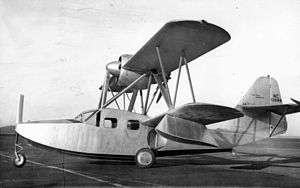Curtiss-Wright CA-1
| CA-1 | |
|---|---|
 | |
| Role | Biplane amphibian |
| National origin | United States |
| Manufacturer | Curtiss-Wright |
| Designer | Frank Courtney |
| First flight | 1935 |
| Number built | 3 |
The Curtiss CA-1 (sometimes known as the Commuter or the Courtney Amphibian) was an American five-seat biplane amphibian designed by Frank Courtney and built by Curtiss-Wright at St Louis, Missouri.[1]
Design and development
Designed by the British test pilot Frank Courtney, the CA-1 was a five-seat amphibian.[1] The CA-1 was powered by a 365 hp (272 kW) Wright 975E-1 radial, cowled and fitted into the leading edge of the top wing driving - through an extension shaft - a pusher propeller.[1] It had a tricycle amphibian landing gear and an enclosed cabin for the pilot and passengers.[1] Only three aircraft were built and they were all sold in Japan,[1] designated LXC by the Imperial Japanese Navy Air Service.[2]
Specifications
Data from [3]
General characteristics
- Crew: one
- Capacity: four passengers
240 lb (110 kg) baggage[4] - Length: 31 ft 0 in (9.45 m)
- Wingspan: 40 ft 0 in (12.19 m)
- Powerplant: 1 × Wright 975E-1 radial, 365 hp (272 kW)
Performance
- Maximum speed: 151 mph (243 km/h; 131 kn)
- Cruise speed: 125 mph (201 km/h; 109 kn)
- Stall speed: 60 mph (97 km/h; 52 kn)
- Range: 550 mi (478 nmi; 885 km)
See also
Related lists
References
Notes
- 1 2 3 4 5 Orbis 1985, p. 1279
- ↑ http://www.globalsecurity.org/military/world/japan/ijnaf-aircraft-other.htm
- ↑ "American airplanes - Curtiss-hypehnates". www.aerofiles.com. 16 April 2009. Retrieved 28 January 2012.
- ↑ Flight 1934 p821
Bibliography
| Wikimedia Commons has media related to Curtiss-Wright CA-1. |
- The Illustrated Encyclopedia of Aircraft (Part Work 1982-1985). Orbis Publishing.
- "Anglo-US Experiment" Flight 14 October 1937
- "Latest Curtiss-Wright Amphibian" Flight 9 August 1934. p821